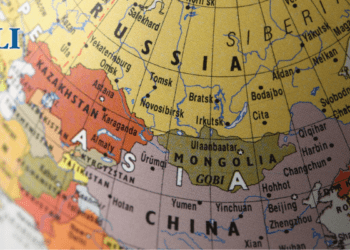This article originally appeared in The Hub.
By Richard Shimooka, June 16, 2025
Last Friday, with nuclear threats and missile defence very much in the news, reports broke that, following President Donald Trump’s very public feud with SpaceX CEO Elon Musk, the company’s role in the proposed new comprehensive defence system was now in question.
The multilayered system, dubbed “Golden Dome,” is planned to protect the American homeland, with capabilities to intercept missiles launched from anywhere around the world.
While Musk and SpaceX may be out, what about Canada?
There are reportedly “high-level” discussions taking place about Canada joining, and in May, Trump declared that participating would require Canada paying $61 billion of the projected price tag (though he added, of course, that it would be free if we became the 51st state).
What should Canada do?
There are real reasons for Canada to be skeptical about the whole project. Ultimately, though, the Carney government must find some accommodation with the Trump administration going forward. The topic of continental defence will undoubtedly be raised at the currently ongoing G7 leaders’ meeting in Kananaskis.
Perhaps the most pressing reason for a more robust missile defence system today is the much more destabilized international system that confronts the United States and its allies. Over the past decade, major adversaries have embarked on a massive buildup of strategic nuclear arms. Russia was the first, starting with a modernization of its strategic nuclear forces in 2010. In 2017, they announced the development of a number of exotic nuclear delivery systems—those that can avoid existing missile sensors and defences. China’s efforts have been more dramatic. Last year, the Defence Intelligence Agency suggested that the Chinese government is pursuing a five-fold increase in deployed nuclear warheads, the majority of which are intended for its strategic nuclear forces. North Korea has also been developing an intercontinental ballistic missile (ICBM) and a miniaturized nuclear warhead capable of striking the United States. Iran’s nuclear ambitions, on the other hand, look to have taken a debilitating hit.
Whether Canadians like it or not, a nuclear weapons arms race has been ongoing for the last decade and is set to continue for the foreseeable future.
Previously, the Canadian-U.S. efforts primarily focused on modernizing and improving the residency of NORAD’s sensors and command and control systems to deal with these threats. This included the development of highly advanced data-processing systems that can vastly improve the acuity of the entire system. In addition, the U.S. continued to improve and expand its existing missile defence architecture. The field has changed significantly since the early 2000s, when Canada last debated the issue, when the Bush administration sought to deploy the Ground Based Midcourse Defence (GBMD) system.
Since then, a multitude of systems have been developed and fielded. These include shorter-ranged systems like Terminal High Altitude Area Defence (THAAD), Patriot PAC3 and the Aegis Combat System, as well as strategic systems like the aforementioned GBMD and Aegis Ashore installations in Europe. In totality, these systems’ overall efficacy and potential military utility are fairly mixed. Combined, they are completely inadequate to defend against a major nuclear exchange with Russia or China (or both at the same time), but could potentially stop a rogue actor’s attack.
Somewhat under the radar, last year the Trudeau government signalled it was planning to drop its opposition to BMD and join the U.S. effort. This was intended to facilitate a more seamless integration of defences, data, and command and control relationships within NORAD.
The Trump factor
Trump’s announcements on the Golden Dome have upended the decade-long effort to modernize NORAD, undermining political support for the programs on both sides of the border. Part of the problem is that he has variously used “Golden Dome” interchangeably to describe either a space-based interceptor (SBI) as well as the existing ballistic missile defence architecture. A “next generation missile shield” will incorporate much of the existing NORAD modernization priorities, some of which are reconfigured to support the administration’s priorities.
The reality of the SBI system is that it is unlikely to produce even a rudimentary capability for at least a decade. It should be seen analogously to the Apollo moon landings—an extremely technically risky program that is in its infancy. The administration’s plan for both the SBI and parts of the broader defence architecture, such as for low-flying cruise missiles, has little to no detail.
According to a preliminary analysis from the Congressional Budget Office, it would require a constellation of 1,000 to 2,000 satellites to provide some defensive capability, and come at a cost of at least $400 billion, far more than the $175 billion price tag the president has claimed. Moreover, that only refers to the SBI portion, not all of the ancillary capabilities essential to enable the Golden Dome to work.
A program of this ambition requires large and stable funding outlays for years to see through to fruition; the current programmatic and funding in Congress are almost certain not to provide that. This year, the DoD budget was a “continuing resolution”—essentially a xerox of Biden’s plan—with $25 billion of Golden Dome funding allocated separately on top. This compromise approach means that the SBI is extremely vulnerable to being defunded in future years.
Even now, many key GOP figures in Congress are clearly unhappy with the administration’s priorities broadly, and the SBI system specifically. The latter is set to eat up increasingly larger portions of the defence budget and distract from more pressing threats, like the Chinese naval buildup in the Pacific. Moreover, the increasing debt incurred by the passing of the recent tax cuts makes the SBI an inviting target for future savings, especially if the House of Representatives falls to the Democrats during the midterms.
A balanced approach
The Carney government will need to strike a delicate balancing act, not just with Trump, but also with its relationship with the U.S. Congress. His claim that he asked Ottawa to pay $61 billion for Golden Dome’s development is reminiscent of the claim that Mexico will pay for a border wall—and just as fanciful. Ignoring it to pursue a more substantive agreement might be the best policy.
The upgrades Canada signed onto for NORAD modernization are critical to make Golden Dome work. Those investments would have happened regardless, even if Trump had lost the election. That’s where Canada’s focus should remain.
First, Ottawa should attempt to play for time. Even six months could provide much more clarity on the program and help determine a better strategy for the country. But at some point, Canada will need to negotiate. The best policy is to keep its promise to modernize NORAD, and incorporate modifications that would enable SBI to operate effectively, but not go much further than what has been previously agreed and funded in previous bilateral meetings. That would land Canada roughly where Congress is while also giving the Trump administration a win, however partial.
But to be sure, Canada will need to make further investments going forward, many of which will be dual-use for the Golden Dome’s SBI system. Despite the superficial rhetoric made by Trump, it’s still clear that Canada and the United States must jointly develop a much more concrete response to the growing strategic nuclear weapons threat.
If Canada can adroitly navigate limiting its participation in the SBI system while strengthening the overall ability for NORAD to respond to the new threat environment, it would be a welcome outcome for the new Carney government.






